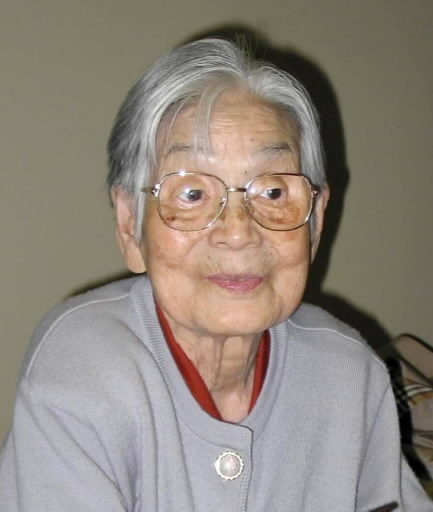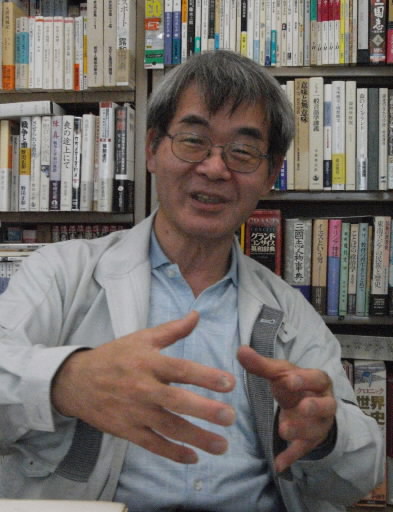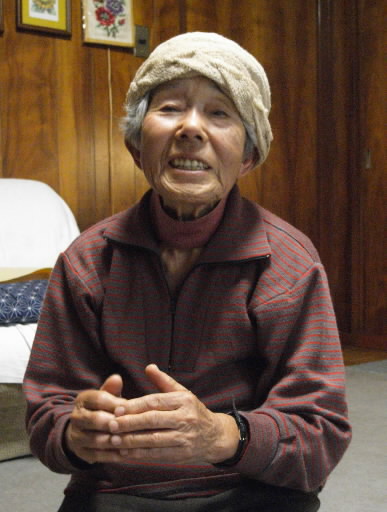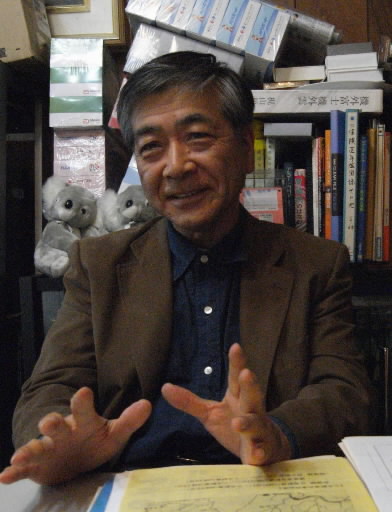Five years since the death of Tomoe Yamashiro
Nov. 13, 2009
by Rie Nii, Staff Writer
November 7 will mark the fifth anniversary of the death of writer Tomoe Yamashiro (1912-2004), an activist who supported atomic bomb survivors and the independence and human rights of rural women in Hiroshima Prefecture. In Fuchu City, her hometown, and in Miyoshi City, which she often visited, citizens are carrying on her wishes through peace and literary activities.
Ms. Yamashiro's novel The Song of the Cart, which was made into a movie, was set in the districts of Sakugi and Funo in Miyoshi City. This work, the result of listening to the voices of rural people, was the starting point for Ms. Yamashiro's lifelong efforts to create a peaceful society where human rights would be preserved and women would be given the opportunity to express themselves.
In 1954, while participating in a drive to collect 1 million signatures prior to the first World Conference Against A & H Bombs, which was to be held in Hiroshima the following year, Ms. Yamashiro visited the northern part of Hiroshima Prefecture. In Miyoshi she met the late Ishi Hino, who served as the model for the novel's protagonist. The former home of the village headman, where Hino was employed, still stands.
The Tomoe Yamashiro Literary Institute, based in Miyoshi, held story-telling sessions at the house for two years after Ms. Yamashiro's death. Since then it has published an annual collection of writings. Akinori Kuroda, 75, who oversees the project, said, "The basis of Yamashiro's philosophy was the notion that people should just write, whether it be an account of hardship or boasting. She believed that if a person's stories could be made into a book it would become their life's treasure." By writing, the members of the institute put into practice Ms. Yamashiro's philosophy, which says that writing fosters individuality and respect for human rights.
In November 1945, shortly after the end of World War II, Ms. Yamashiro saw for the first time the devastation that the atomic bombing had wrought in Hiroshima. After that she worked toward the creation of an organization for atomic bomb survivors in the days prior to the formation of the Japan Confederation of A- and H-Bomb Sufferers Organizations (Hidankyo). Her focus on the weaker members of society led her to edit Kono Sekai no Katasumi de (In One Corner of the World) about those suffering from microcephaly as the result of exposure to radiation while in the womb. This effort raised awareness of these patients. Ms. Yamashiro also established the "Mushroom Society" for the patients and their families.
Chizuko Uchida, 86, of Fuchu began writing about her life at the urging of Ms. Yamashiro, who told her, "Even three lines is okay." Ms. Uchida's book 1945 Hachigatsu Kara no Shuppatsu (Starting Out from August 1945) was published in 1977. In the book, Ms. Uchida describes her experiences of caring for atomic bomb survivors. She continues to urge others to write, and publishes two volumes of writings nearly every month, providing ongoing opportunities for self-expression.
In 1983 Hitoshi Kai, 59, joined with Ms. Uchida and others to form a group in Fuchu focusing on the reading of Ms. Yamashiro's works. Motivated by the 1986 accident at the nuclear plant in Chernobyl, Mr. Kai also formed the "Junod Society" to provide aid to the victims there, and has made repeated trips to Chernobyl. His insistence on providing aid directly to individuals is a reflection of Ms. Yamashiro’s philosophy.
June 1912: Born in Kuribu Village, Hiroshima Prefecture (now part of Fuchu City)
March 1937: Marries labor activist Yoshimune Yamashiro
May 1940: Arrested along with Yoshimune and sentenced to four years in prison for aiding and abetting violations of the Peace Preservation Law
January 1945 : Yoshimune dies in prison
August 1945: Paroled from prison with two months remaining on sentence
November 1945: Called by General Headquarters of the Allied Forces (GHQ), sees A-bombed Hiroshima for the first time
August 1949: Begins survey of atomic bomb survivors
August 1952: Forms Atomic Bomb Survivors Association with Ken Kawate and others
September 1952: With Sankichi Toge and others, publishes poetry anthology Genshigumo no Shita Yori (From Under the Atomic Bomb Cloud)
August 1956: Song of the Cart published
January 1959: Forms "Dandelion Society" study group with three other women in Joge-cho (now part of the City of Fuchu)
June 1965: Establishes "Mushroom Society" for patients suffering from microcephaly as the result of exposure to radiation while in the womb and their families
December 1973: Rentai no Tankyu (Pursuit of Solidarity) published
April 1977: 1945 Hachigatsu Kara no Shuppatsu (Starting Out from August 1945) by Chizuko Uchida published as the first volume in a series of accounts of daily life by women in eastern and northeastern Hiroshima Prefecture
August 1986: 10-volume work Toraware no Onnatachi (Captive Women) completed
April 2000: Tomoe Yamashiro Collection opens in Mirasaka Town (now part of Miyoshi City)
November 2004: Dies in hospital in Tokyo at the age of 92
Hitoshi Kai, 59, chairman of the Junod Society, Fuchu
Putting into practice the philosophy of dealing with people one-to-one
After the explosion at the nuclear plant in Chernobyl in April 1986, Mr. Kai wanted to go there to help with the relief operation, but he had no idea how to go about it. In September 1988 he joined with Ms. Yamashiro and others to set up a group to study the life of Marcel Junod, a Swiss doctor who delivered medical supplies to Hiroshima shortly after the atomic bombing. That marked the start of his support efforts.
Just as Ms. Yamashiro approached atomic bomb survivors in Hiroshima on an individual basis, Mr. Kai continued to seek meetings with Chernobyl victims, saying he wanted his support to go to individual victims, not the victims as a group. He set up a system by which to give the medical charts for Chernobyl victims suffering from thyroid disease who were examined by doctors from Hiroshima to local doctors and the patients themselves. More than 1,000 victims have been examined so far. "I've finally reached the point where I can ease off a bit," Mr. Kai said.
Mr. Kai first met Ms. Yamashiro when he was in college. Moved by her depiction of the pursuit of ties between individuals in her novel Rentai no Tankyu (Pursuit of Solidarity), he sought her out. Although he was young enough to be her son, Ms. Yamashiro began making frequent visits to Mr. Kai's home, and they remained friends for the rest of her life. "We were always arguing, but she was a remarkable woman who made a living solely through writing," Mr. Kai said.
Mr. Kai is also proceeding with research into the life of Masakazu Nakai (1900-1952), a scholar of esthetics and a native of Takehara who was a close friend of Ms. Yamashiro. "I heard through the grapevine that Ms. Yamashiro said she thought it could be done if I tackled the project," he said.
Chizuko Uchida, 86, publisher of Chikasui and Okyagarikoboshi, Fuchu
Continuing to write, recalling encouragement
The collection of writings entitled Chikasui (Groundwater) has been published nearly every month for a total of 306 issues, and 192 issues of Okyagarikoboshi (Tumble Doll) have been published. Both of them consist of eight pages in B5 format. Of the approximately 10 members of the group, six or seven contribute to each issue. Ms. Uchida also writes for the publications about recent events or things that happened when she was young. “I have to express what I think no matter what others think," she said.
Underlying this sentiment is her experience of being exposed to radiation upon entering Hiroshima after the bombing. After being compelled to work at a hospital in the burned-out city that had escaped destruction, Ms. Uchida was providing aid to atomic bomb survivors when the war ended. "They said things like ‘I don't want to die. Why didn't the war end sooner?’ I am possessed by the thoughts of those who died. The feeling that there must be no more atomic bombs or wars is ingrained in me."
The first issue of Chikasui was published in 1975. Ms. Uchida recalled those days. "Ms. Yamashiro said to me, 'If women don't speak up for themselves, we'll get caught up in another war.' I wanted to develop these ideas among women so we could follow in her footsteps.”
By the time the 100th edition was published around 1990, Ms. Uchida was starting to get tired of typing up long manuscripts on the word processor and was ready to throw in the towel. But she was inspired to carry on when Ms. Yamashiro told her: "By having your work read by others, you become a better person," she said. She launched a new publication, Okyagarikoboshi, in 1992. Since then she has written at least two essays and compiled the manuscripts of other group members for both publications each month. "I want to publish their works in book form," she said.
Norio Takaba, 62, director of the Tomoe Yamashiro Literary Institute, Miyoshi
Working on compilation of speeches
Mirasaka Town, a neighborhood that has worked to create a community based on peace, human rights and culture, is now part of the City of Miyoshi. In 2000, prior to annexation, the Tomoe Yamashiro Collection was established to house papers and documents donated by Ms. Yamashiro, and in 2002 the literary institute was established.
The institute publishes a semiannual newsletter and an annual collection of writings, Tsuchi to Kurashi no Bungei (Literature Living with the Earth). Initially, the institute had nearly 90 members, but for various reasons, including the aging of the members, the group has dwindled to 55. "We can't do as much as we'd like to," Mr. Takaba said.
Nevertheless, there are many pressing tasks the institute must tackle, Mr. Nakaba said, including cataloging the 3,000 items in the collection, making changes to the displays, and compiling records of Ms. Yamashiro's activities related to her writing and the speeches she gave during her travels around the country.
Ms. Yamashiro approached the atomic bomb survivors as individuals, not as a group. "That philosophy is just as applicable today," Mr. Takaba said.
Mr. Takaba believes that in modern society people tend to rely on groups and are becoming less able to be independent. This sort of society has a lot to learn from Ms. Yamashiro, he said. Pointing to Ms. Yamashiro's significant work to establish the Mushroom Society, a group for patients suffering from microcephaly as the result of exposure to radiation while in the womb and their families, he believes that a new solidarity between the atomic bomb survivors and the community can be created.
Mr. Takaba said he is considering cooperating with similar groups that are working to carry on Ms. Yamashiro's ideas.
(Originally published November 2, 2009)
To comment on this article, please click the link below. Comments will be moderated and posted in a timely fashion. Comments may also appear in the Chugoku Shimbun newspaper.
Author wrote about atomic bomb survivors and rural life
November 7 will mark the fifth anniversary of the death of writer Tomoe Yamashiro (1912-2004), an activist who supported atomic bomb survivors and the independence and human rights of rural women in Hiroshima Prefecture. In Fuchu City, her hometown, and in Miyoshi City, which she often visited, citizens are carrying on her wishes through peace and literary activities.
Ms. Yamashiro's novel The Song of the Cart, which was made into a movie, was set in the districts of Sakugi and Funo in Miyoshi City. This work, the result of listening to the voices of rural people, was the starting point for Ms. Yamashiro's lifelong efforts to create a peaceful society where human rights would be preserved and women would be given the opportunity to express themselves.
In 1954, while participating in a drive to collect 1 million signatures prior to the first World Conference Against A & H Bombs, which was to be held in Hiroshima the following year, Ms. Yamashiro visited the northern part of Hiroshima Prefecture. In Miyoshi she met the late Ishi Hino, who served as the model for the novel's protagonist. The former home of the village headman, where Hino was employed, still stands.
The Tomoe Yamashiro Literary Institute, based in Miyoshi, held story-telling sessions at the house for two years after Ms. Yamashiro's death. Since then it has published an annual collection of writings. Akinori Kuroda, 75, who oversees the project, said, "The basis of Yamashiro's philosophy was the notion that people should just write, whether it be an account of hardship or boasting. She believed that if a person's stories could be made into a book it would become their life's treasure." By writing, the members of the institute put into practice Ms. Yamashiro's philosophy, which says that writing fosters individuality and respect for human rights.
In November 1945, shortly after the end of World War II, Ms. Yamashiro saw for the first time the devastation that the atomic bombing had wrought in Hiroshima. After that she worked toward the creation of an organization for atomic bomb survivors in the days prior to the formation of the Japan Confederation of A- and H-Bomb Sufferers Organizations (Hidankyo). Her focus on the weaker members of society led her to edit Kono Sekai no Katasumi de (In One Corner of the World) about those suffering from microcephaly as the result of exposure to radiation while in the womb. This effort raised awareness of these patients. Ms. Yamashiro also established the "Mushroom Society" for the patients and their families.
Chizuko Uchida, 86, of Fuchu began writing about her life at the urging of Ms. Yamashiro, who told her, "Even three lines is okay." Ms. Uchida's book 1945 Hachigatsu Kara no Shuppatsu (Starting Out from August 1945) was published in 1977. In the book, Ms. Uchida describes her experiences of caring for atomic bomb survivors. She continues to urge others to write, and publishes two volumes of writings nearly every month, providing ongoing opportunities for self-expression.
In 1983 Hitoshi Kai, 59, joined with Ms. Uchida and others to form a group in Fuchu focusing on the reading of Ms. Yamashiro's works. Motivated by the 1986 accident at the nuclear plant in Chernobyl, Mr. Kai also formed the "Junod Society" to provide aid to the victims there, and has made repeated trips to Chernobyl. His insistence on providing aid directly to individuals is a reflection of Ms. Yamashiro’s philosophy.
The Life of Tomoe Yamashiro
June 1912: Born in Kuribu Village, Hiroshima Prefecture (now part of Fuchu City)
March 1937: Marries labor activist Yoshimune Yamashiro
May 1940: Arrested along with Yoshimune and sentenced to four years in prison for aiding and abetting violations of the Peace Preservation Law
January 1945 : Yoshimune dies in prison
August 1945: Paroled from prison with two months remaining on sentence
November 1945: Called by General Headquarters of the Allied Forces (GHQ), sees A-bombed Hiroshima for the first time
August 1949: Begins survey of atomic bomb survivors
August 1952: Forms Atomic Bomb Survivors Association with Ken Kawate and others
September 1952: With Sankichi Toge and others, publishes poetry anthology Genshigumo no Shita Yori (From Under the Atomic Bomb Cloud)
August 1956: Song of the Cart published
January 1959: Forms "Dandelion Society" study group with three other women in Joge-cho (now part of the City of Fuchu)
June 1965: Establishes "Mushroom Society" for patients suffering from microcephaly as the result of exposure to radiation while in the womb and their families
December 1973: Rentai no Tankyu (Pursuit of Solidarity) published
April 1977: 1945 Hachigatsu Kara no Shuppatsu (Starting Out from August 1945) by Chizuko Uchida published as the first volume in a series of accounts of daily life by women in eastern and northeastern Hiroshima Prefecture
August 1986: 10-volume work Toraware no Onnatachi (Captive Women) completed
April 2000: Tomoe Yamashiro Collection opens in Mirasaka Town (now part of Miyoshi City)
November 2004: Dies in hospital in Tokyo at the age of 92
Three people's recollections of Tomoe Yamashiro
Hitoshi Kai, 59, chairman of the Junod Society, Fuchu
Putting into practice the philosophy of dealing with people one-to-one
After the explosion at the nuclear plant in Chernobyl in April 1986, Mr. Kai wanted to go there to help with the relief operation, but he had no idea how to go about it. In September 1988 he joined with Ms. Yamashiro and others to set up a group to study the life of Marcel Junod, a Swiss doctor who delivered medical supplies to Hiroshima shortly after the atomic bombing. That marked the start of his support efforts.
Just as Ms. Yamashiro approached atomic bomb survivors in Hiroshima on an individual basis, Mr. Kai continued to seek meetings with Chernobyl victims, saying he wanted his support to go to individual victims, not the victims as a group. He set up a system by which to give the medical charts for Chernobyl victims suffering from thyroid disease who were examined by doctors from Hiroshima to local doctors and the patients themselves. More than 1,000 victims have been examined so far. "I've finally reached the point where I can ease off a bit," Mr. Kai said.
Mr. Kai first met Ms. Yamashiro when he was in college. Moved by her depiction of the pursuit of ties between individuals in her novel Rentai no Tankyu (Pursuit of Solidarity), he sought her out. Although he was young enough to be her son, Ms. Yamashiro began making frequent visits to Mr. Kai's home, and they remained friends for the rest of her life. "We were always arguing, but she was a remarkable woman who made a living solely through writing," Mr. Kai said.
Mr. Kai is also proceeding with research into the life of Masakazu Nakai (1900-1952), a scholar of esthetics and a native of Takehara who was a close friend of Ms. Yamashiro. "I heard through the grapevine that Ms. Yamashiro said she thought it could be done if I tackled the project," he said.
Chizuko Uchida, 86, publisher of Chikasui and Okyagarikoboshi, Fuchu
Continuing to write, recalling encouragement
The collection of writings entitled Chikasui (Groundwater) has been published nearly every month for a total of 306 issues, and 192 issues of Okyagarikoboshi (Tumble Doll) have been published. Both of them consist of eight pages in B5 format. Of the approximately 10 members of the group, six or seven contribute to each issue. Ms. Uchida also writes for the publications about recent events or things that happened when she was young. “I have to express what I think no matter what others think," she said.
Underlying this sentiment is her experience of being exposed to radiation upon entering Hiroshima after the bombing. After being compelled to work at a hospital in the burned-out city that had escaped destruction, Ms. Uchida was providing aid to atomic bomb survivors when the war ended. "They said things like ‘I don't want to die. Why didn't the war end sooner?’ I am possessed by the thoughts of those who died. The feeling that there must be no more atomic bombs or wars is ingrained in me."
The first issue of Chikasui was published in 1975. Ms. Uchida recalled those days. "Ms. Yamashiro said to me, 'If women don't speak up for themselves, we'll get caught up in another war.' I wanted to develop these ideas among women so we could follow in her footsteps.”
By the time the 100th edition was published around 1990, Ms. Uchida was starting to get tired of typing up long manuscripts on the word processor and was ready to throw in the towel. But she was inspired to carry on when Ms. Yamashiro told her: "By having your work read by others, you become a better person," she said. She launched a new publication, Okyagarikoboshi, in 1992. Since then she has written at least two essays and compiled the manuscripts of other group members for both publications each month. "I want to publish their works in book form," she said.
Norio Takaba, 62, director of the Tomoe Yamashiro Literary Institute, Miyoshi
Working on compilation of speeches
Mirasaka Town, a neighborhood that has worked to create a community based on peace, human rights and culture, is now part of the City of Miyoshi. In 2000, prior to annexation, the Tomoe Yamashiro Collection was established to house papers and documents donated by Ms. Yamashiro, and in 2002 the literary institute was established.
The institute publishes a semiannual newsletter and an annual collection of writings, Tsuchi to Kurashi no Bungei (Literature Living with the Earth). Initially, the institute had nearly 90 members, but for various reasons, including the aging of the members, the group has dwindled to 55. "We can't do as much as we'd like to," Mr. Takaba said.
Nevertheless, there are many pressing tasks the institute must tackle, Mr. Nakaba said, including cataloging the 3,000 items in the collection, making changes to the displays, and compiling records of Ms. Yamashiro's activities related to her writing and the speeches she gave during her travels around the country.
Ms. Yamashiro approached the atomic bomb survivors as individuals, not as a group. "That philosophy is just as applicable today," Mr. Takaba said.
Mr. Takaba believes that in modern society people tend to rely on groups and are becoming less able to be independent. This sort of society has a lot to learn from Ms. Yamashiro, he said. Pointing to Ms. Yamashiro's significant work to establish the Mushroom Society, a group for patients suffering from microcephaly as the result of exposure to radiation while in the womb and their families, he believes that a new solidarity between the atomic bomb survivors and the community can be created.
Mr. Takaba said he is considering cooperating with similar groups that are working to carry on Ms. Yamashiro's ideas.
(Originally published November 2, 2009)
To comment on this article, please click the link below. Comments will be moderated and posted in a timely fashion. Comments may also appear in the Chugoku Shimbun newspaper.











